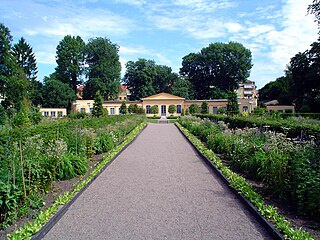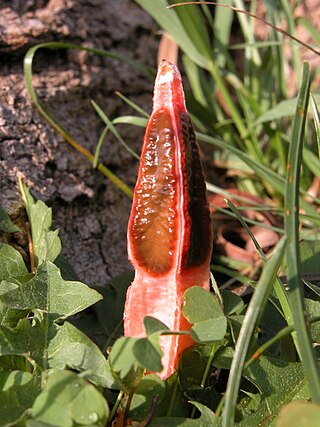In mycology, a sanctioned name is a name that was adopted (but not necessarily coined) in certain works of Christiaan Hendrik Persoon or Elias Magnus Fries, which are considered major points in fungal taxonomy.
In mycology, a sanctioned name is a name that was adopted (but not necessarily coined) in certain works of Christiaan Hendrik Persoon or Elias Magnus Fries, which are considered major points in fungal taxonomy.
Sanctioned names are those, regardless of their authorship, that were used by Persoon in his Synopsis Methodica Fungorum (1801) for rusts, smuts and gasteromycetes, and in Fries's Systema Mycologicum (three volumes, published 1821–1832) and Elenchus fungorum for all other fungi. [1]
A sanctioned name, as defined under article 15 of the International Code of Nomenclature for algae, fungi, and plants (previously, the International Code of Botanical Nomenclature) is automatically treated as if conserved against all earlier synonyms or homonyms. [2] It can still, however, be conserved or rejected normally.
Because of the imprecision associated with assigning starting dates for fungi sanctioned in Fries' three Systema volumes, the Stockholm 1950 International Botanical Congress defined arbitrary or actual publication dates for the starting points to improve the stability of nomenclature. These dates were 1 May 1753 for Species Plantarum (vascular plants), 31 December 1801 for Synopsis Methodica Fungorum, 31 December 1820 for Flora der Vorweldt (fossil plants), and 1 January 1821 for the first volume of Systema. Because fungi defined in the second and third volumes lacked a starting-point book for reference, the Congress declared that these species, in addition to species defined in Fries' 1828 Elenchus Fungorum (a two-volume supplement to his System), had "privileged status". According to Korf, [1] the term "sanctioned" was first used to indicate these privileged names by the Dutch mycologist Marinus Anton Donk in 1961. [3]
In 1982, changes in the International Code for Botanical Nomenclature (the Sydney Code) restored Linnaeus' 1753 Species Plantarum as the starting point for fungal nomenclature; however, protected status was given to all names adopted by Persoon in his 1801 Synopsis, and by Fries in both the Systema and the Elenchus. [1] [4] Soon after, in 1983, Richard P. Korf proposed the now widely accepted "colon-author indication", whereby sanctioned names are indicated by including ": Pers." or ": Fr." when fully citing the species author. [5]

Elias Magnus Fries was a Swedish mycologist and botanist. He is sometimes called the "Linnaeus of Mycology". In his works he described and assigned botanical names to hundreds of fungus and lichen species, many of which remain authoritative today.

Christiaan Hendrik Persoon was a South African mycologist who made additions to Linnaeus' mushroom taxonomy.

Order is one of the eight major hierarchical taxonomic ranks in Linnaean taxonomy. It is classified between family and class. In biological classification, the order is a taxonomic rank used in the classification of organisms and recognized by the nomenclature codes. An immediately higher rank, superorder, is sometimes added directly above order, with suborder directly beneath order. An order can also be defined as a group of related families.

The International Code of Nomenclature for algae, fungi, and plants is the set of rules and recommendations dealing with the formal botanical names that are given to plants, fungi and a few other groups of organisms, all those "traditionally treated as algae, fungi, or plants". It was formerly called the International Code of Botanical Nomenclature (ICBN); the name was changed at the International Botanical Congress in Melbourne in July 2011 as part of the Melbourne Code which replaced the Vienna Code of 2005.

In biological nomenclature, a syntype is any one of two or more biological types that is listed in a description of a taxon where no holotype was designated. Precise definitions of this and related terms for types have been established as part of the International Code of Zoological Nomenclature and the International Code of Nomenclature for algae, fungi, and plants.
Nomenclature codes or codes of nomenclature are the various rulebooks that govern the naming of living organisms. Standardizing the scientific names of biological organisms allows researchers to discuss findings.
In botanical nomenclature, a hybrid may be given a hybrid name, which is a special kind of botanical name, but there is no requirement that a hybrid name should be created for plants that are believed to be of hybrid origin. The International Code of Nomenclature for algae, fungi, and plants (ICNafp) provides the following options in dealing with a hybrid:
In botany, the phrase ordo naturalis, 'natural order', was once used for what today is a family. Its origins lie with Carl Linnaeus who used the phrase when he referred to natural groups of plants in his lesser-known work, particularly Philosophia Botanica. In his more famous works the Systema Naturae and the Species Plantarum, plants were arranged according to his artificial "Sexual system", and Linnaeus used the word ordo for an artificial unit. In those works, only genera and species were "real" taxa.

Entoloma sinuatum is a poisonous mushroom found across Europe and North America. Some guidebooks refer to it by its older scientific names of Entoloma lividum or Rhodophyllus sinuatus. The largest mushroom of the genus of pink-spored fungi known as Entoloma, it is also the type species. Appearing in late summer and autumn, fruit bodies are found in deciduous woodlands on clay or chalky soils, or nearby parklands, sometimes in the form of fairy rings. Solid in shape, they resemble members of the genus Tricholoma. The ivory to light grey-brown cap is up to 20 cm (7.9 in) across with a margin that is rolled inward. The sinuate gills are pale and often yellowish, becoming pink as the spores develop. The thick whitish stem has no ring.

Priority is a fundamental principle of modern botanical nomenclature and zoological nomenclature. Essentially, it is the principle of recognising the first valid application of a name to a plant or animal. There are two aspects to this:

Lysurus mokusin, commonly known as the lantern stinkhorn, the small lizard's claw, or the ribbed lizard claw, is a saprobic species of fungus in the family Phallaceae. The fruit body consists of a reddish, cylindrical fluted stipe that is capped with several "arms". The arms can approach or even close in on each other to form a spire. The gleba—an olive-green slimy spore mass—is carried on the outer surface of the arms. The fruit body has an odor comparable to "fresh dog feces", "rotting flesh", or "sewage" when mature.

Gomphus clavatus, commonly known as pig's ears or the violet chanterelle, is an edible species of fungus in the genus Gomphus native to Eurasia and North America. Described by Jacob Christian Schäffer in 1774, G. clavatus has had several name changes and many alternative scientific names, having been classified in the genus Cantharellus, though it is not closely related to them. The fruit body is vase- or fan-shaped with wavy edges to its rim, and grows up to 15–16 cm wide and 17 cm tall. The upper surface or cap is orangish-brown to lilac, while the lower spore-bearing surface, the hymenium, is covered in wrinkles and ridges rather than gills or pores, and is a distinctive purple color.

Peniophora is a genus of fungi which are plant pathogens. Members of the genus belong to the class Agaricomycetes, order Russulales, and family Peniophoraceae. The genus is widespread, and contains 62 species. The species of Peniophora are resupinate, or crust-like, and are described as corticioid. A number of its members are parasitised by other fungi. For example, Tremella mesenterica is a parasite to several species of Peniophora.

Cortinarius violaceus, commonly known as the violet webcap or violet cort, is a fungus in the webcap genus Cortinarius native across the Northern Hemisphere. The fruit bodies are dark purple mushrooms with caps up to 15 cm (6 in) across, sporting gills underneath. The stalk measures 6 to 12 centimetres by 1 to 2 cm, sometimes with a thicker base. The dark flesh has a smell reminiscent of cedar wood. Forming symbiotic (ectomycorrhizal) relationships with the roots of various plant species, C. violaceus is found predominantly in conifer forests in North America and deciduous forests in Europe.
In biological nomenclature, the principle of typification is one of the guiding principles.

The gasteroid fungi are a group of fungi in the Basidiomycota. Species were formerly placed in the obsolete class Gasteromycetes Fr., or the equally obsolete order Gasteromycetales Rea, because they produce spores inside their basidiocarps rather than on an outer surface. However, the class is polyphyletic, as such species—which include puffballs, earthstars, stinkhorns, and false truffles—are not closely related to each other. Because they are often studied as a group, it has been convenient to retain the informal (non-taxonomic) name of "gasteroid fungi".

Guepinia is a genus of fungus in the Auriculariales order. It is a monotypic genus, containing the single species Guepinia helvelloides, commonly known as the apricot jelly. The fungus produces salmon-pink, ear-shaped, gelatinous fruit bodies that grow solitarily or in small tufted groups on soil, usually associated with buried rotting wood. The fruit bodies are up to 10 cm (4 in) tall and up to 17 cm wide; the stalks are not well-differentiated from the cap. It has a white spore deposit, and the oblong to ellipsoid spores measure 9–11 by 5–6 micrometers.

Serpula is a genus of fungi in the family Serpulaceae.

Melanoleuca melaleuca is a species of mushroom in the family Tricholomataceae, and it is the type species of its genus Melanoleuca. It is difficult to distinguish from other related species firstly because it is variable, secondly because the taxonomic criteria are often based on characteristics which have later been found to be variable, and thirdly because there is much disagreement between authorities as to exactly how the species should be defined.